Lenovo 20AN009CUS, 20AN00DEUS, 20AN006NUS User manual

User Guide
ThinkPad T440p
Note: Before using this information and the product it supports, be sure to read and understand the following:
•Safety, Warranty, and Setup Guide
•Regulatory Notice
•“Important safety information” on page vi
•Appendix E “Notices” on page 159
The latest Safety, Warranty, and Setup Guide and the Regulatory Notice are available on the Lenovo Support Web site at:
http://www.lenovo.com/ThinkPadUserGuides
First Edition (September 2013)
© Copyright Lenovo 2013.
LIMITED AND RESTRICTED RIGHTS NOTICE: If data or software is delivered pursuant a General Services Administration “GSA” contract, use, reproduction, or disclosure is subject to restrictions set forth in Contract No. GS-35F-05925.

Contents
Read this first . . . . . . . . . . . . . . |
v |
Important safety information . . . . . . . . . . |
vi |
Conditions that require immediate action . . |
vii |
Safety guidelines . . . . . . . . . . . . |
vii |
Chapter 1. Product overview . . . . . . |
1 |
Locating computer controls, connectors, and |
|
indicators. . . . . . . . . . . . . . . . . . |
1 |
Front view. . . . . . . . . . . . . . . . |
1 |
Right-side view. . . . . . . . . . . . . . |
3 |
Left-side view . . . . . . . . . . . . . . |
5 |
Bottom view . . . . . . . . . . . . . . . |
6 |
Rear view . . . . . . . . . . . . . . . . |
7 |
Status indicators . . . . . . . . . . . . . |
8 |
Locating important product information . . . . . . |
9 |
Machine type and model information . . . . . |
9 |
FCC ID and IC Certification information . . . . |
9 |
Certificate of Authenticity information . . . . |
10 |
Genuine Microsoft label . . . . . . . . . |
11 |
Features . . . . . . . . . . . . . . . . . |
11 |
Specifications . . . . . . . . . . . . . . . |
13 |
Operating environment . . . . . . . . . . . |
13 |
Lenovo programs . . . . . . . . . . . . . |
14 |
Accessing Lenovo programs on the Windows |
|
7 operating system . . . . . . . . . . . |
14 |
Accessing Lenovo programs on the Windows |
|
8 operating system . . . . . . . . . . . |
15 |
Lenovo program overview . . . . . . . . |
16 |
Chapter 2. Using your computer . . . |
19 |
Registering your computer . . . . . . . . . . |
19 |
Frequently asked questions . . . . . . . . . |
19 |
Special keys . . . . . . . . . . . . . . . |
21 |
Function keys and key combinations . . . . |
21 |
Windows key . . . . . . . . . . . . . |
22 |
Using the ThinkPad pointing device . . . . . . |
22 |
Power management . . . . . . . . . . . . |
24 |
Checking the battery status . . . . . . . . |
24 |
Using the ac power adapter. . . . . . . . |
25 |
Charging the battery . . . . . . . . . . |
25 |
Maximizing the battery life . . . . . . . . |
26 |
Managing the battery power . . . . . . . |
26 |
Power-saving modes . . . . . . . . . . |
26 |
Connecting to the network . . . . . . . . . . |
27 |
Ethernet connections . . . . . . . . . . |
27 |
Wireless connections . . . . . . . . . . |
27 |
Presentations and multimedia. . . . . . . . . |
31 |
Changing display settings . . . . . . . . |
31 |
Connecting a projector or an external |
|
monitor . . . . . . . . . . . . . . . . |
31 |
Setting up a presentation. . . . . . . . . |
34 |
Using dual displays . . . . . . . . . . . |
34 |
Using the NVIDIA Optimus Graphics feature . . . |
35 |
Using audio features . . . . . . . . . . . . |
35 |
Using the camera . . . . . . . . . . . . . |
35 |
Using the optical drive . . . . . . . . . . . |
36 |
Using a flash media card. . . . . . . . . . . |
36 |
Chapter 3. You and your computer . . 39
Accessibility and comfort . . . . . . . . . . |
39 |
Ergonomic information. . . . . . . . . . |
39 |
Comfort . . . . . . . . . . . . . . . |
40 |
Accessibility information . . . . . . . . . |
40 |
Traveling with your computer . . . . . . . . . |
41 |
Travel tips . . . . . . . . . . . . . . . |
41 |
Travel accessories . . . . . . . . . . . |
42 |
Chapter 4. Security . . . . . . . . . . |
43 |
Using passwords. . . . . . . . . . . . . . |
43 |
Typing passwords . . . . . . . . . . . |
43 |
Power-on password . . . . . . . . . . . |
43 |
Supervisor password . . . . . . . . . . |
44 |
Hard disk passwords . . . . . . . . . . |
45 |
Hard disk security . . . . . . . . . . . . . |
47 |
Setting the security chip . . . . . . . . . . . |
48 |
Using the fingerprint reader. . . . . . . . . . |
49 |
Notice on deleting data from your hard disk drive |
|
or solid-state drive . . . . . . . . . . . . . |
52 |
Using firewalls . . . . . . . . . . . . . . . |
53 |
Protecting data against viruses . . . . . . . . |
53 |
Chapter 5. Recovery overview . . . . |
55 |
Recovery overview for the Windows 7 operating |
|
system . . . . . . . . . . . . . . . . . . |
55 |
Creating and using recovery media . . . . . |
55 |
Performing backup and recovery operations . |
56 |
Using the Rescue and Recovery workspace . |
57 |
Creating and using a rescue medium . . . . |
58 |
Reinstalling preinstalled programs and device |
|
drivers . . . . . . . . . . . . . . . . |
59 |
Solving recovery problems . . . . . . . . |
60 |
Recovery overview for the Windows 8 operating |
|
system . . . . . . . . . . . . . . . . . . |
60 |
Refreshing your computer . . . . . . . . |
60 |
© Copyright Lenovo 2013 |
i |
Resetting your computer to the factory default |
|
settings. . . . . . . . . . . . . . . . |
60 |
Using the advanced startup options . . . . |
61 |
Recovering your operating system if Windows |
|
8 fails to start . . . . . . . . . . . . . |
61 |
Creating and using recovery media . . . . . |
61 |
Chapter 6. Replacing devices . . . . . |
63 |
Static electricity prevention. . . . . . . . . . |
63 |
Replacing the battery pack . . . . . . . . . . |
63 |
Replacing the base cover assembly . . . . . . |
65 |
Installing or replacing the SIM card. . . . . . . |
66 |
Replacing the hard disk drive or solid-state drive . |
67 |
Replacing a memory module . . . . . . . . . |
70 |
Replacing the M.2 wireless LAN card . . . . . . |
72 |
Installing or replacing the M.2 wireless WAN |
|
card . . . . . . . . . . . . . . . . . . . |
76 |
Replacing the Ultrabay device . . . . . . . . |
79 |
Replacing the backup battery . . . . . . . . . |
82 |
Replacing the keyboard . . . . . . . . . . . |
84 |
Chapter 7. Enhancing your |
|
computer . . . . . . . . . . . . . . . |
91 |
Finding ThinkPad options . . . . . . . . . . |
91 |
ThinkPad docking stations . . . . . . . . . . |
91 |
Locating controls and connectors on the |
|
ThinkPad docking stations . . . . . . . . |
91 |
Attaching a ThinkPad docking station . . . . |
96 |
Detaching a ThinkPad docking station . . . |
97 |
Connecting external displays to a docking |
|
station . . . . . . . . . . . . . . . . |
98 |
Security features . . . . . . . . . . . . |
99 |
Chapter 8. Advanced
configuration . . . . . . . . . . . . 101
Installing a new operating system . . . . . . . 101
Installing the Windows 7 operating system . . 101 Installing the Windows 8 operating system . . 102
Installing device drivers . . . . . . . . . . . |
103 |
Using the ThinkPad Setup program . . . . . . |
103 |
Main menu . . . . . . . . . . . . . . |
104 |
Config menu. . . . . . . . . . . . . . |
104 |
Date and Time menu . . . . . . . . . . |
109 |
Security menu . . . . . . . . . . . . . |
109 |
Startup menu . . . . . . . . . . . . . |
114 |
Restart menu . . . . . . . . . . . . . |
115 |
Updating the UEFI BIOS . . . . . . . . . |
115 |
Using system management. . . . . . . . . . |
116 |
Setting management features . . . . . . . |
116 |
Chapter 9. Preventing problems . . 119
General tips for preventing problems . . . . . . 119
Making sure device drivers are current . . . . . |
120 |
Taking care of your computer . . . . . . . . . |
121 |
Cleaning the cover of your computer . . . . |
122 |
Chapter 10. Troubleshooting |
|
computer problems . . . . . . . . . |
125 |
Diagnosing problems . . . . . . . . . . . . |
125 |
Troubleshooting . . . . . . . . . . . . . . |
125 |
Computer stops responding . . . . . . . |
125 |
Spills on the keyboard . . . . . . . . . . |
126 |
Error messages . . . . . . . . . . . . |
126 |
Errors without messages . . . . . . . . . |
128 |
Beep errors . . . . . . . . . . . . . . |
128 |
Memory module problems . . . . . . . . |
129 |
Networking problems . . . . . . . . . . |
129 |
Problems with the keyboard and other pointing |
|
devices . . . . . . . . . . . . . . . . |
131 |
Problems with the display and multimedia |
|
devices . . . . . . . . . . . . . . . . |
132 |
Fingerprint reader problems. . . . . . . . |
135 |
Battery and power problems . . . . . . . |
135 |
Problems with drives and other storage |
|
devices . . . . . . . . . . . . . . . . |
138 |
A software problem . . . . . . . . . . . |
139 |
Problems with ports and connectors . . . . |
140 |
Chapter 11. Getting support . . . . |
141 |
Before you contact Lenovo . . . . . . . . . . |
141 |
Getting help and service . . . . . . . . . . . |
141 |
Using diagnostic programs . . . . . . . . |
142 |
Lenovo Support Web site. . . . . . . . . |
142 |
Calling Lenovo . . . . . . . . . . . . . |
142 |
Purchasing additional services . . . . . . . . |
143 |
Appendix A. Regulatory |
|
Information . . . . . . . . . . . . . |
145 |
Wireless related information . . . . . . . . . |
145 |
Locations of the UltraConnect™ wireless |
|
antennas . . . . . . . . . . . . . . . |
146 |
Locating wireless regulatory notices . . . . |
147 |
Export classification notice . . . . . . . . . . |
147 |
Electronic emission notices. . . . . . . . . . |
147 |
Federal Communications Commission |
|
Declaration of Conformity . . . . . . . . |
147 |
Industry Canada Class B emission compliance |
|
statement . . . . . . . . . . . . . . . |
147 |
European Union - Compliance to the |
|
Electromagnetic Compatibility Directive . . . |
148 |
German Class B compliance statement . . . |
148 |
Korea Class B compliance statement . . . . |
149 |
Japan VCCI Class B compliance statement . . 149
Japan compliance statement for products which connect to the power mains with
ii User Guide

rated current less than or equal to 20 A per
phase . . . . . . . . . . . . . . . . 149
Lenovo product service information for
Taiwan . . . . . . . . . . . . . . . . 149
Eurasian compliance mark . . . . . . . . . . 149
Appendix B. WEEE and recycling statements . . . . . . . . . . . . . 151
Important WEEE information . . . . . . . . . 151
Recycling information for Japan . . . . . . . . 151
Battery recycling information for Brazil . . . . . 152
Battery recycling information for Taiwan . . . . . 152
Battery recycling information for the European
Union . . . . . . . . . . . . . . . . . . 153
Battery recycling information for the United States
and Canada . . . . . . . . . . . . . . . . 153
Appendix C. Restriction of Hazardous Substances Directive (RoHS) . . . . 155
European Union RoHS . . . . . . . . . . . |
155 |
China RoHS. . . . . . . . . . . . . . . . |
155 |
India RoHS . . . . . . . . . . . . . . . . |
155 |
Turkish RoHS . . . . . . . . . . . . . . . |
155 |
Ukraine RoHS . . . . . . . . . . . . . . . |
156 |
Appendix D. ENERGY STAR model information . . . . . . . . . . . . . 157
Appendix E. Notices . . . . . . . . . 159
Trademarks . . . . . . . . . . . . . . . . 160
© Copyright Lenovo 2013 |
iii |
iv User Guide
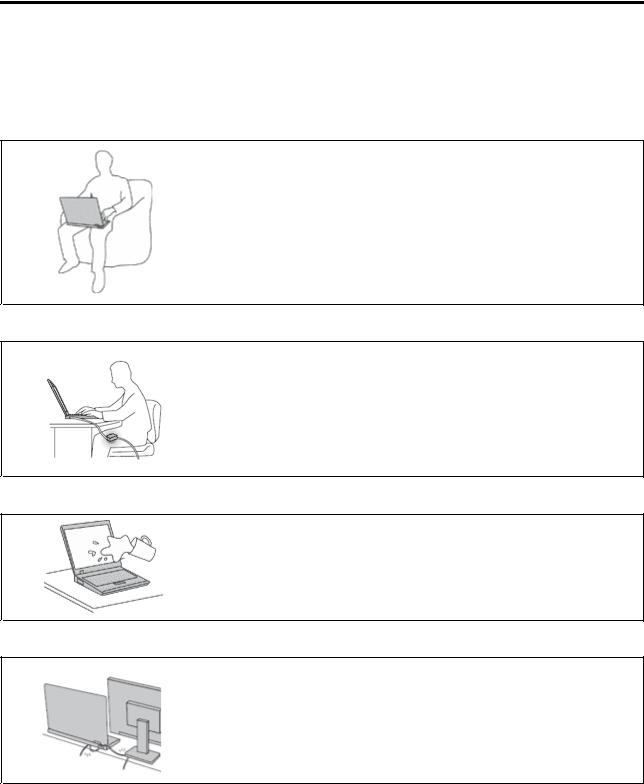
Read this first
Be sure to follow the important tips given here to get the most use and enjoyment out of your computer. Failure to do so might lead to discomfort or injury, or cause your computer to fail.
Protect yourself from the heat that your computer generates.
When your computer is turned on or the battery is charging, the base, the palm rest, and some other parts may become hot. The temperature they reach depends on the amount of system activity and the level of charge in the battery.
Extended contact with your body, even through clothing, could cause discomfort or even a skin burn.
•Avoid keeping your hands, your lap, or any other part of your body in contact with a hot section of the computer for any extended time.
•Periodically take hands from using the keyboard by lifting your hands from the palm rest.
Protect yourself from the heat generated by the ac power adapter.
When the ac power adapter is connected to an electrical outlet and your computer, it generates heat.
Extended contact with your body, even through clothing, may cause a skin burn.
•Do not place the ac power adapter in contact with any part of your body while it is in use.
•Never use it to warm your body.
Prevent your computer from getting wet.
To avoid spills and the danger of electrical shock, keep liquids away from your computer.
Protect the cables from being damaged.
Applying strong force to cables may damage or break them.
Route communication lines, or the cables of an ac power adapter, a mouse, a keyboard, a printer, or any other electronic device, so that they cannot be walked on, tripped over, pinched by your computer or other objects, or in any way subjected to treatment that could interfere with the operation of your computer.
© Copyright Lenovo 2013 |
v |
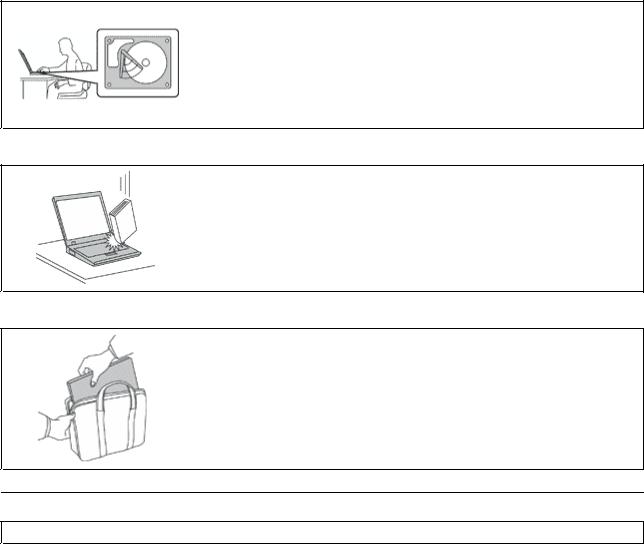
Protect your computer and data when moving it.
Before moving a computer equipped with a hard disk drive, do one of the following, and make sure that the power button is off or is blinking:
•Turn it off.
•Put it in sleep mode.
•Put it in hibernation mode.
This will help to prevent damage to the computer, and possible loss of data.
Handle your computer gently.
Do not drop, bump, scratch, twist, hit, vibrate, push, or place heavy objects on your computer, display, or external devices.
Carry your computer carefully.
•Use a quality carrying case that provides adequate cushioning and protection.
•Do not pack your computer in a tightly packed suitcase or bag.
•Before putting your computer in a carrying case, make sure that it is off, in sleep mode, or in hibernation mode. Do not put a computer in a carrying case while it is turned on.
Important safety information
Note: Read the important safety information first.
This information can help you safely use your notebook computer. Follow and retain all information included with your computer. The information in this document does not alter the terms of your purchase agreement or the Lenovo® Limited Warranty. For more information, see “Warranty Information” in the Safety, Warranty, and Setup Guide that comes with your computer.
Customer safety is important. Our products are developed to be safe and effective. However, personal computers are electronic devices. Power cords, power adapters, and other features can create potential safety risks that can result in physical injury or property damage, especially if misused. To reduce these risks, follow the instructions included with your product, observe all warnings on the product and in the operating instructions, and review the information included in this document carefully. By carefully following the information contained in this document and provided with your product, you can help protect yourself from hazards and create a safer computer work environment.
Note: This information includes references to power adapters and batteries. In addition to notebook computers, some products (such as speakers and monitors) ship with external power adapters. If you have such a product, this information applies to your product. In addition, computer products contain a coin-sized internal battery that provides power to the system clock even when the computer is unplugged, so the battery safety information applies to all computer products.
vi User Guide
Conditions that require immediate action
Products can become damaged due to misuse or neglect. Some product damage is serious enough that the product should not be used again until it has been inspected and, if necessary, repaired by an authorized servicer.
As with any electronic device, pay close attention to the product when it is turned on. On very rare occasions, you might notice an odor or see a puff of smoke or sparks vent from your product. Or you might hear sounds like popping, cracking or hissing. These conditions might merely mean that an internal electronic component has failed in a safe and controlled manner. Or, they might indicate
a potential safety issue. However, do not take risks or attempt to diagnose the situation yourself. Contact the Customer Support Center for further guidance. For a list of Service and Support phone numbers, see the following Web site:
http://www.lenovo.com/support/phone
Frequently inspect your computer and its components for damage or wear or signs of danger. If you have any question about the condition of a component, do not use the product. Contact the Customer Support Center or the product manufacturer for instructions on how to inspect the product and have it repaired, if necessary.
In the unlikely event that you notice any of the following conditions, or if you have any safety concerns with your product, stop using the product and unplug it from the power source and telecommunication lines until you can speak to the Customer Support Center for further guidance.
•Power cords, plugs, power adapters, extension cords, surge protectors, or power supplies that are cracked, broken, or damaged.
•Signs of overheating, smoke, sparks, or fire.
•Damage to a battery (such as cracks, dents, or creases), discharge from a battery, or a buildup of foreign substances on the battery.
•A cracking, hissing or popping sound, or strong odor that comes from the product.
•Signs that liquid has been spilled or an object has fallen onto the computer product, the power cord or power adapter.
•The computer product, power cord, or power adapter has been exposed to water.
•The product has been dropped or damaged in any way.
•The product does not operate normally when you follow the operating instructions.
Note: If you notice these conditions with a product (such as an extension cord) that is not manufactured for or by Lenovo, stop using that product until you can contact the product manufacturer for further instructions, or until you get a suitable replacement.
Safety guidelines
Always observe the following precautions to reduce the risk of injury and property damage.
Service and upgrades
Do not attempt to service a product yourself unless instructed to do so by the Customer Support Center or your documentation. Only use a Service Provider who is approved to repair your particular product.
Note: Some computer parts can be upgraded or replaced by the customer. Upgrades typically are referred to as options. Replacement parts approved for customer installation are referred to as Customer Replaceable Units, or CRUs. Lenovo provides documentation with instructions when it is appropriate for customers to install options or replace CRUs. You must closely follow all instructions when installing or replacing parts. The Off state of a power indicator does not necessarily mean that voltage levels inside a
© Copyright Lenovo 2013 |
vii |
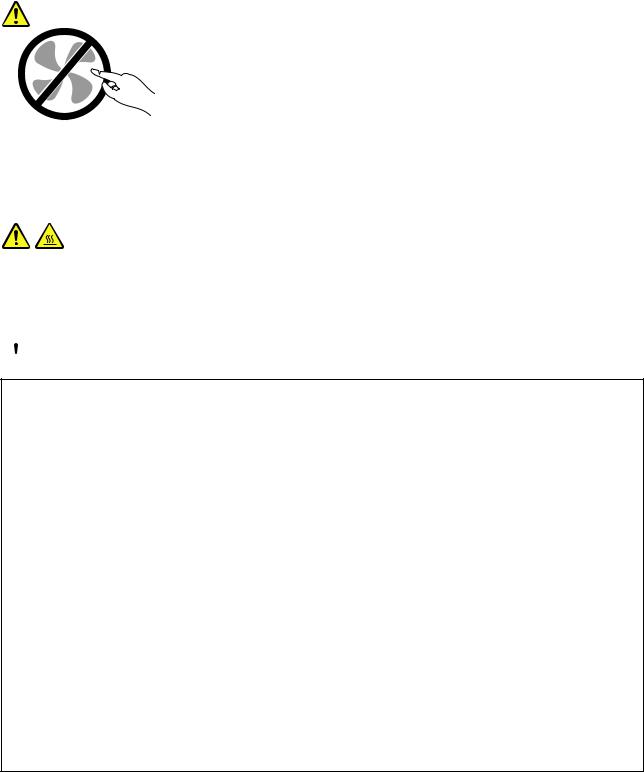
product are zero. Before you remove the covers from a product equipped with a power cord, always make sure that the power is turned off and that the product is unplugged from any power source. If you have any questions or concerns, contact the Customer Support Center.
Although there are no moving parts in your computer after the power cord has been disconnected, the following warnings are required for your safety.
CAUTION:
Hazardous moving parts. Keep fingers and other body parts away.
CAUTION:
Before replacing any CRUs, turn off the computer and wait three to five minutes to let the computer cool before opening the cover.
Power cords and power adapters
 DANGER
DANGER
Use only the power cords and power adapters supplied by the product manufacturer.
The power cords shall be safety approved. For Germany, it shall be H05VV-F, 3G, 0.75 mm2, or better. For other countries, the suitable types shall be used accordingly.
Never wrap a power cord around a power adapter or other object. Doing so can stress the cord in ways that can cause the cord to fray, crack, or crimp. This can present a safety hazard.
Always route power cords so that they will not be walked on, tripped over, or pinched by objects.
Protect power cords and power adapters from liquids. For instance, do not leave your power cord or power adapter near sinks, tubs, toilets, or on floors that are cleaned with liquid cleansers. Liquids can cause a short circuit, particularly if the power cord or power adapter has been stressed by misuse. Liquids also can cause gradual corrosion of power cord terminals and/or the connector terminals on a power adapter, which can eventually result in overheating.
Always connect power cords and signal cables in the correct order and ensure that all power cord connectors are securely and completely plugged into receptacles.
Do not use any power adapter that shows corrosion at the ac input pins or shows signs of overheating (such as deformed plastic) at the ac input pins or anywhere on the power adapter.
Do not use any power cords where the electrical contacts on either end show signs of corrosion or overheating or where the power cord appears to have been damaged in any way.
viii User Guide
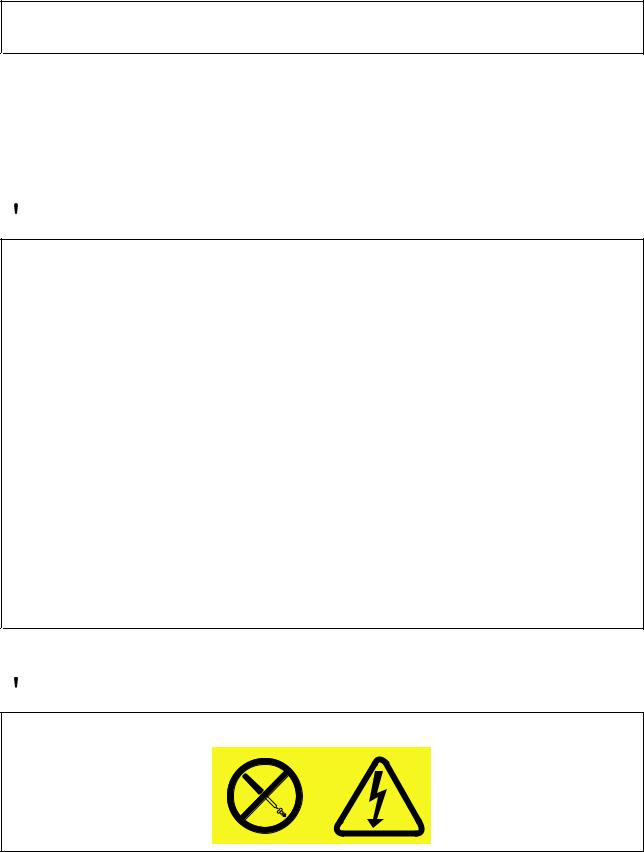
To prevent possible overheating, do not cover the power adapter with clothing or other objects when the power adapter is plugged into an electrical outlet.
Extension cords and related devices
Ensure that extension cords, surge protectors, uninterruptible power supplies, and power strips that you use are rated to handle the electrical requirements of the product. Never overload these devices. If power strips are used, the load should not exceed the power strip input rating. Consult an electrician for more information if you have questions about power loads, power requirements, and input ratings.
Plugs and outlets
 DANGER
DANGER
If a receptacle (power outlet) that you intend to use with your computer equipment appears to be damaged or corroded, do not use the outlet until it is replaced by a qualified electrician.
Do not bend or modify the plug. If the plug is damaged, contact the manufacturer to obtain a replacement.
Do not share an electrical outlet with other home or commercial appliances that draw large amounts of electricity; otherwise, unstable voltage might damage your computer, data, or attached devices.
Some products are equipped with a three-pronged plug. This plug fits only into a grounded electrical outlet. This is a safety feature. Do not defeat this safety feature by trying to insert it into a non-grounded outlet. If you cannot insert the plug into the outlet, contact an electrician for an approved outlet adapter or to replace the outlet with one that enables this safety feature. Never overload an electrical outlet. The overall system load should not exceed 80 percent of the branch circuit rating. Consult an electrician for more information if you have questions about power loads and branch circuit ratings.
Be sure that the power outlet you are using is properly wired, easily accessible, and located close to the equipment. Do not fully extend power cords in a way that will stress the cords.
Be sure that the power outlet provides the correct voltage and current for the product you are installing.
Carefully connect and disconnect the equipment from the electrical outlet.
Power supply statement
 DANGER
DANGER
Never remove the cover on a power supply or any part that has the following label attached.
© Copyright Lenovo 2013 |
ix |

Hazardous voltage, current, and energy levels are present inside any component that has this label attached. There are no serviceable parts inside these components. If you suspect a problem with one of these parts, contact a service technician.
External devices
CAUTION:
Do not connect or disconnect any external device cables other than USB cables while the computer power is on; otherwise, you might damage your computer. To avoid possible damage to attached devices, wait at least five seconds after the computer is shut down to disconnect external devices.
General battery notice
 DANGER
DANGER
Personal computers manufactured by Lenovo contain a coin cell battery to provide power to the system clock. In addition, many mobile products, such as notebook computers, utilize a
rechargeable battery pack to provide system power when in portable mode. Batteries supplied by Lenovo for use with your product have been tested for compatibility and should only be replaced with approved parts.
Never attempt to open or service any battery. Do not crush, puncture, or incinerate batteries or short circuit the metal contacts. Do not expose the battery to water or other liquids. Only recharge the battery pack strictly according to instructions included in the product documentation.
Battery abuse or mishandling can cause the battery to overheat, which can cause gasses or flame to “vent” from the battery pack or coin cell. If your battery is damaged, or if you notice any discharge from your battery or the buildup of foreign materials on the battery leads, stop using the battery and obtain a replacement from the battery manufacturer.
Batteries can degrade when they are left unused for long periods of time. For some rechargeable batteries (particularly Lithium Ion batteries), leaving a battery unused in a discharged state could increase the risk of a battery short circuit, which could shorten the life of the battery and also can pose a safety hazard. Do not let rechargeable Lithium-Ion batteries completely discharge or store these batteries in a discharged state.
Notice for lithium coin cell battery
 DANGER
DANGER
Danger of explosion if battery is incorrectly replaced.
Do not:
•Throw or immerse into water
•Heat to more than 100°C (212°F)
•Repair or disassemble
Dispose of the battery as required by local ordinances or regulations.
The following statement applies to users in the state of California, U.S.A.
California Perchlorate Information:
x User Guide

Products containing manganese dioxide lithium coin cell batteries may contain perchlorate.
Perchlorate Material - special handling may apply, See
www.dtsc.ca.gov/hazardouswaste/perchlorate
Rechargeable battery notice
 DANGER
DANGER
Do not attempt to disassemble or modify the battery pack. Attempting to do so can cause an explosion, or liquid leakage from the battery pack. A battery pack other than the one specified by Lenovo, or a disassembled or modified battery pack is not covered by the warranty.
If the rechargeable battery pack is incorrectly replaced, there is danger of an explosion. The battery pack contains a small amount of harmful substances. To avoid possible injury:
•Replace only with a battery of the type recommended by Lenovo.
•Keep the battery pack away from fire.
•Do not expose it to water or rain.
•Do not attempt to disassemble it.
•Do not short-circuit it.
•Keep it away from children.
•Do not drop the battery pack.
Do not put the battery pack in trash that is disposed of in landfills. When disposing of the battery, comply with local ordinances or regulations.
The battery pack should be stored at room temperature, charged to approximately 30 to 50% of capacity. We recommend that battery pack be charged about once per year to prevent overdischarge.
Heat and product ventilation
 DANGER
DANGER
Computers, ac power adapters, and many accessories can generate heat when turned on and when batteries are charging. Notebook computers can generate a significant amount of heat due to their compact size. Always follow these basic precautions:
•When your computer is turned on or the battery is charging, the base, the palm rest, and some other parts may become hot. Avoid keeping your hands, your lap, or any other part of your body in contact with a hot section of the computer for any extended length of time. When you use the keyboard, avoid keeping your palms on the palm rest for a prolonged period of time. Your computer generates some heat during normal operation. The amount of heat depends on the amount of system activity and the battery charge level. Extended contact with your body, even through clothing, could cause discomfort or even a skin burn. Periodically take breaks from using the keyboard by lifting your hands from the palm rest; and be careful not to use the keyboard for any extended length of time.
•Do not operate your computer or charge the battery near flammable materials or in explosive environments.
© Copyright Lenovo 2013 |
xi |

•Ventilation slots, fans and/or heat sinks are provided with the product for safety, comfort, and reliable operation. These features might inadvertently become blocked by placing the product on a bed, sofa, carpet, or other flexible surface. Never block, cover, or disable these features.
•When the ac power adapter is connected to an electrical outlet and your computer, it generates heat. Do not place the adapter in contact with any part of your body while using it. Never use the ac power adapter to warm your body. Extended contact with your body, even through clothing, may cause a skin burn.
For your safety, always follow these basic precautions with your computer:
•Keep the cover closed whenever the computer is plugged in.
•Regularly inspect the outside of the computer for dust accumulation.
•Remove dust from vents and any perforations in the bezel. More frequent cleanings might be required for computers in dusty or high-traffic areas.
•Do not restrict or block any ventilation openings.
•Do not operate your computer inside furniture, as this might increase the risk of overheating.
•Airflow temperatures into the computer should not exceed 35°C (95°F).
Electrical current safety information
 DANGER
DANGER
Electric current from power, telephone, and communication cables is hazardous.
To avoid a shock hazard:
•Do not use your computer during a lightning storm.
•Do not connect or disconnect any cables or perform installation, maintenance, or reconfiguration of this product during an electrical storm.
•Connect all power cords to a properly wired and grounded electrical outlet.
•Connect to properly wired outlets any equipment that will be attached to this product.
•Whenever possible, use one hand only to connect or disconnect signal cables.
•Never turn on any equipment when there is evidence of fire, water, or structural damage.
•Do not use your computer until all internal parts enclosures are fastened into place. Never use the computer when internal parts and circuits are exposed.
 DANGER
DANGER
Connect and disconnect cables as described in the following procedures when installing, moving, or opening covers on this product or attached devices.
To connect:
1.Turn everything OFF.
2.First, attach all cables to devices.
3.Attach signal cables to connectors.
4.Attach power cords to outlets.
5.Turn devices ON.
To disconnect:
1.Turn everything OFF.
2.First, remove power cords from outlets.
3.Remove signal cables from connectors.
4.Remove all cables from devices.
xii User Guide
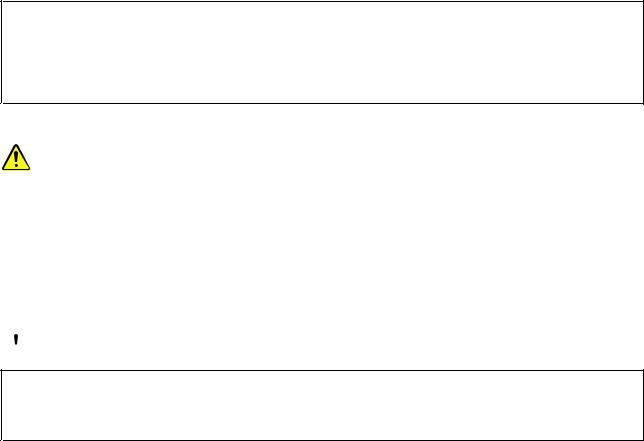
The power cord must be disconnected from the wall outlet or receptacle before installing all other electrical cables connected to the computer.
The power cord may be reconnected to the wall outlet or receptacle only after all other electrical cables have been connected to the computer.
Laser compliance statement
CAUTION:
When laser products (such as CD-ROMs, DVD drives, fiber optic devices, or transmitters) are installed, note the following:
•Do not remove the covers. Removing the covers of the laser product could result in exposure to hazardous laser radiation. There are no serviceable parts inside the device.
•Use of controls or adjustments or performance of procedures other than those specified herein might result in hazardous radiation exposure.
 DANGER
DANGER
Some laser products contain an embedded Class 3A or Class 3B laser diode. Note the following:
Laser radiation when open. Do not stare into the beam, do not view directly with optical instruments, and avoid direct exposure to the beam.
Liquid crystal display (LCD) notice
CAUTION:
The liquid crystal display (LCD) is made of glass, and rough handling or dropping the computer can cause the LCD to break. If the LCD breaks and the internal fluid gets into your eyes or on your hands, immediately wash the affected areas with water for at least 15 minutes; if any symptoms are present after washing, get medical care.
Note: For products with mercury-containing fluorescent lamps (for example, non-LED), the fluorescent lamp in the liquid crystal display (LCD) contains mercury; dispose of according to local, state, or federal laws.
Using headphones or earphones
If your computer has both a headphone connector and an audio-out connector, always use the headphone connector for headphones (also called a headset) or earphones.
CAUTION:
Excessive sound pressure from earphones and headphones can cause hearing loss. Adjustment of the equalizer to maximum increases the earphone and headphone output voltage and the sound pressure level. Therefore, to protect your hearing, adjust the equalizer to an appropriate level.
Excessive use of headphones or earphones for a long period of time at high volume can be dangerous if the output of the headphone or earphone connectors do not comply with specifications of EN 50332-2. The headphone output connector of your computer complies with EN 50332-2 Sub clause 7. This specification limits the computer’s maximum wide band true RMS output voltage to 150 mV. To help protect against hearing loss, ensure that the headphones or earphones you use also comply with EN 50332-2 (Clause 7 limits) for a wide band characteristic voltage of 75 mV. Using headphones that do not comply with EN 50332-2 can be dangerous due to excessive sound pressure levels.
© Copyright Lenovo 2013 |
xiii |

If your Lenovo computer came with headphones or earphones in the package, as a set, the combination of the headphones or earphones and the computer already complies with the specifications of EN 50332-1. If different headphones or earphones are used, ensure that they comply with EN 50332-1 (Clause 6.5 Limitation Values). Using headphones that do not comply with EN 50332-1 can be dangerous due to excessive sound pressure levels.
Additional safety information
 DANGER
DANGER
Plastic bags can be dangerous. Keep plastic bags away from babies and children to avoid danger of suffocation.
Notice for users in the U.S.A.
Many personal computer products and accessories contain cords, cables or wires, such as power cords or cords to connect the accessory to a personal computer. If this product has such a cord, cable or wire, then the following warning applies:
WARNING: Handling the cord on this product or cords associated with accessories sold with this product will expose you to lead, a chemical known to the State of California to cause cancer, and birth defects or other reproductive harm. Wash hands after handling.
Save these instructions.
xiv User Guide
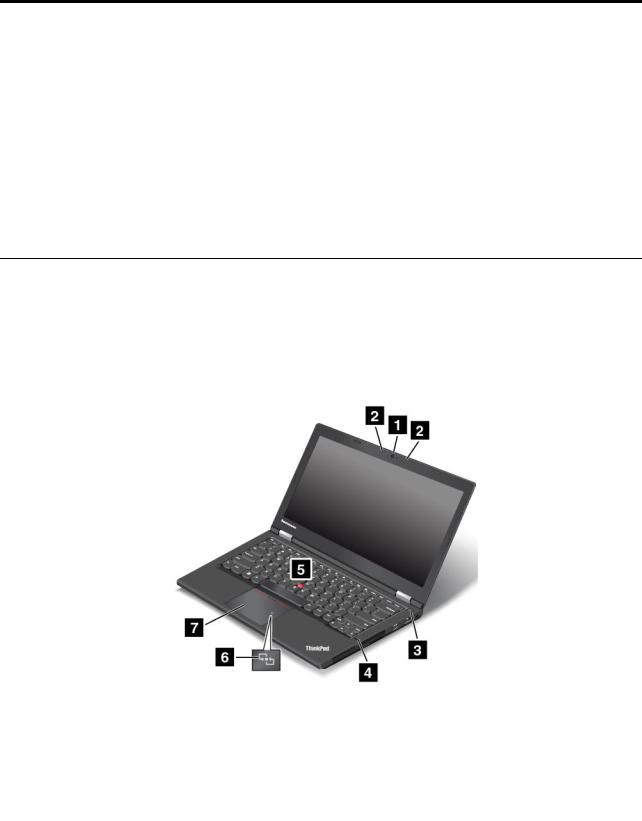
Chapter 1. Product overview
This chapter provides information about the locations of connectors, locations of important product labels, computer features, specifications, operating environment, and preinstalled programs.
•“Locating computer controls, connectors, and indicators” on page 1
•“Locating important product information” on page 9
•“Features” on page 11
•“Specifications” on page 13
•“Operating environment” on page 13
•“Lenovo programs” on page 14
Locating computer controls, connectors, and indicators
This section introduces the computer hardware features to give you the basic information you will need to start using the computer.
Front view
Figure 1. Front view
|
|
Camera (on some models) |
|
|
TrackPoint® pointing stick |
|
1 |
|
5 |
||
|
|
|
|
|
|
|
|
Microphones |
|
|
NFC logo (on some models) |
|
2 |
|
6 |
||
|
|
|
|
|
|
|
|
Power button |
|
|
ThinkPad® trackpad |
|
3 |
|
7 |
||
|
|
|
|
|
|
|
|
Fingerprint reader (on some models) |
|
|
|
|
4 |
|
|
|
|
|
|
|
|
|
|
© Copyright Lenovo 2013 |
1 |

1 |
Camera (on some models) |
Use the camera to take pictures or hold a video conference. For more information, see “Using the camera” on page 35.
2 |
Microphones |
The microphones capture sound and voice when used with a program capable of handling audio.
3 |
Power button |
Use the power button to turn on the computer.
To turn off the computer, use the Start menu shutdown option on the Microsoft® Windows® 7 operating system. For the Microsoft Windows 8 operating system, move the cursor to the top-right or bottom-right corner of the screen to display the charms. Then click Settings Power Shut down.
If your computer stops responding and you cannot turn it off, press and hold the power button for four seconds or more. If the computer still is not responding, remove the ac power adapter and the battery to reset the computer.
You also can program the power button so that by pressing the power button you can turn off the computer or put the computer into sleep or hibernation mode. To achieve this, you need to change your power plan settings. To access power plan settings, do the following:
•For Windows 7: Start the Power Manager program and then click the Power Plan tab. For instructions on how to start the Power Manager program, see “Accessing Lenovo programs on the Windows 7 operating system” on page 14.
•For Windows 8: Click the battery status icon from the Windows notification area and click More power options. Then click Choose what the power buttons do.
4 |
Fingerprint reader (on some models) |
Fingerprint authentication technology provides a simple and secure user access by associating your fingerprint with passwords. For more information, see “Using the fingerprint reader” on page 49.
ThinkPad pointing device
5 |
TrackPoint pointing stick |
|
ThinkPad trackpad |
7 |
The keyboard contains the Lenovo unique ThinkPad pointing devices. Pointing, selecting, and dragging are all part of a single process that you can perform without moving your fingers from a typing position. For more information, see “Using the ThinkPad pointing device” on page 22.
6 |
NFC logo (on some models) |
If there is a Near Field Communication (NFC) logo on the trackpad of your computer, it indicates that your computer supports the NFC feature. For more information, see “Using the NFC connection” on page 31.
2 User Guide

Right-side view
Figure 2. Right-side view
|
|
Smart card slot (on some models) |
|
|
USB connector |
|
1 |
|
4 |
||
|
|
|
|
|
|
|
|
Serial Ultrabay™ Enhanced bay |
|
|
Security-lock slot |
|
2 |
|
5 |
||
|
|
|
|
|
|
|
|
Always On USB connector |
|
|
|
|
3 |
|
|
|
|
|
|
|
|
|
|
1 |
Smart card slot (on some models) |
Your computer might have a smart card slot.
2 |
Serial Ultrabay Enhanced bay |
Your computer has a bay for Serial Ultrabay Enhanced devices. For some models, an optical drive is installed in the bay. For certain models, a secondary hard disk drive is installed.
3 |
Always On USB connector |
By default, the Always On Universal Serial Bus (USB) connector enables you to charge some mobile digital devices and smartphones in the following situations:
•When your computer is on or in sleep mode
•When your computer is in hibernation mode or is turned off, but connected to ac power
If you want to charge these devices when the computer is in hibernation mode or is turned off, and the computer is not connected to ac power, do the following:
•For Windows 7: Start the Power Manager program and click the Global Power Settings tab. Then select the Enable USB charge from the computer battery even when the computer is off check box, and click OK or Apply.
•For Windows 8: Press the Windows key to go to the Start screen. Click Lenovo Settings Power. Then select the Enable USB charge from the computer battery even when the computer is off check box.
Attention: When you attach a USB cable to this connector, ensure that the USB mark is facing upward. Otherwise the connector might be damaged.
Chapter 1. Product overview 3

4 |
USB connector |
The USB connector is used for connecting USB-compatible devices, such as a USB printer or a digital camera.
Attention: When you attach a USB cable to this connector, ensure that the USB mark is facing upward. Otherwise the connector might be damaged.
5 |
Security-lock slot |
To protect your computer from theft, you can purchase a security cable lock that fits the security-lock slot to lock the computer to a stationary object.
Note: You are responsible for evaluating, selecting, and implementing the locking device and security feature. Lenovo makes no comments, judgments, or warranties about the function, quality, or performance of the locking device and security feature.
4 User Guide
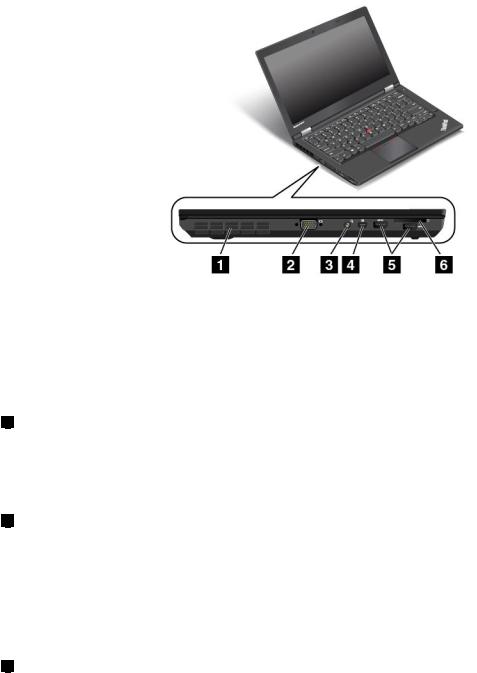
Left-side view
Figure 3. Left-side view
|
|
Fan louvers |
|
|
Mini DisplayPort connector |
|
1 |
|
4 |
||
|
|
|
|
|
|
|
|
VGA connector |
|
|
USB 3.0 connectors |
|
2 |
|
5 |
||
|
|
|
|
|
|
|
|
Audio connector |
|
|
Media card reader slot |
|
3 |
|
6 |
||
|
|
|
|
|
|
1 |
Fan louvers |
The fan louvers and internal fan enable air to circulate in the computer and to ensure proper cooling, especially the cooling of the microprocessor.
Note: To ensure proper airflow, do not place any obstacles in front of the fan louvers.
2 |
VGA connector |
Use the Video Graphics Array (VGA) connector to connect the computer to a VGA-compatible video device, such as a VGA monitor.
Note: If you attach the computer to a docking station, use the VGA connector on the docking station, not the one on the computer.
For more information, see “Using an external monitor” on page 31.
3 |
Audio connector |
Connect headphones or a headset that has a 3.5-mm (0.14-inch), 4-pole plug to the audio connector to listen to the sound from the computer.
Notes:
•If you are using a headset with a function switch, for example, a headset for an iPhone mobile digital device, do not press this switch while using the headset. If you press the switch, the headset microphone will be disabled, and the integrated microphones on the computer will be enabled instead.
Chapter 1. Product overview 5

•The audio connector does not support a conventional microphone. For more information, see “Using audio features” on page 35.
4 |
Mini DisplayPort connector |
Use the mini DisplayPort connector to connect your computer to a compatible projector, external monitor, or high-definition television. For more information, see “Using the mini DisplayPort connector” on page 34.
5 |
USB 3.0 connectors |
The USB 3.0 connectors are used for connecting USB-compatible devices, such as a USB printer or a digital camera.
Attention: When you attach a USB cable to this connector, ensure that the USB mark is facing upward. Otherwise the connector might be damaged.
6 |
Media card reader slot |
Insert your flash media card into this slot to read the data on the card.
Bottom view
Figure 4. Bottom view
|
|
Battery pack |
|
|
Keyboard drainage holes |
|
1 |
|
4 |
||
|
|
|
|
|
|
|
|
SIM card slot |
|
|
Speakers |
|
2 |
|
5 |
||
|
|
|
|
|
|
|
|
Docking station connector |
|
|
|
|
3 |
|
|
|
|
|
|
|
|
|
|
1 |
Battery pack |
Use the computer with the battery power whenever ac power is unavailable.
You can use the Power Manager program to adjust your power settings as needed. For detailed information, see the help information system of the Power Manager program.
2 |
SIM card slot |
If your computer supports the wireless Wide Area Network (wireless WAN) feature, a Subscriber Identification Module (SIM) card might be required to establish wireless WAN connections. Depending on the country or region of delivery, the SIM card might be already installed in the SIM card slot. For more information, see “Installing or replacing the SIM card” on page 66.
6 User Guide
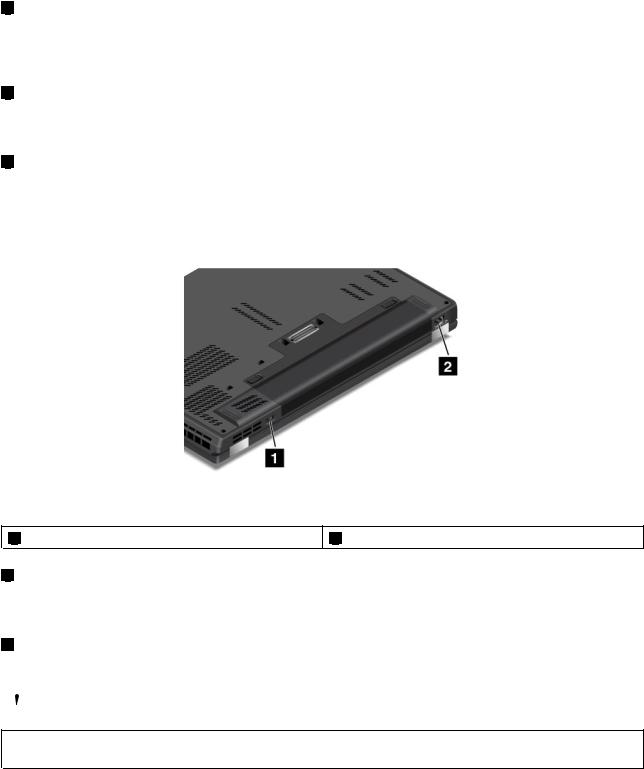
3 |
Docking station connector |
You can use the connector to connect the computer to a supported docking station to extend the computer capabilities when you are at the office or at home. For more information about the supported docking stations, see “ThinkPad docking stations” on page 91.
4 |
Keyboard drainage holes |
The keyboard drainage holes can help drain out liquid from your computer if you accidentally spill water or drink over the keyboard.
5 |
Speakers |
Your computer is equipped with a pair of stereo speakers.
Rear view
Figure 5. Rear view |
|
|
|
1 |
Power connector |
2 |
Ethernet connector |
1 |
Power connector |
|
|
Connect the ac power adapter to the power connector to provide ac power to the computer and charge the battery.
2 |
Ethernet connector |
Connect the computer to a local area network (LAN) with the Ethernet connector.
 DANGER
DANGER
To avoid the risk of electrical shock, do not connect the telephone cable to the Ethernet connector. You can only connect an Ethernet cable to this connector.
The Ethernet connector has two indicators that show the status of the network connection. When the top-left indicator is solid green, it indicates that the computer connects to a LAN and a session with the network is available. When the top-right indicator blinks yellow, it indicates that data is being transmitted.
Note: If you attach the computer to a docking station, use the Ethernet connector on the docking station to connect to a LAN, not the one on the computer.
Chapter 1. Product overview 7

Status indicators
The status indicators show the current status of your computer.
1 |
Fn Lock indicator |
The Fn Lock indicator shows the status of Fn Lock function. For more information, see “Special keys” on page 21.
2 |
Speaker mute indicator |
When the speaker mute indicator is on, the speakers are muted.
3 |
Microphone mute indicator |
When the microphone mute indicator is on, the microphones are muted.
4 |
Camera status indicator |
When the camera status indicator is on, the camera is in use.
5 |
6 |
System status indicators |
The indicator in the ThinkPad logo and the indicator in the center of the power button show the system status of the computer.
8 User Guide

•Blinks for three times: The computer is initially connected to power.
•On: The computer is on (in normal mode).
•Blinks fast: The computer is entering sleep or hibernation mode.
•Blinks slowly: The computer is in sleep mode.
•Off: The computer is off or in hibernation mode.
Locating important product information
This section provides information to help you locate the machine type and model label, the FCC ID and IC Certification label, the Windows Certificate of Authenticity label, and the Genuine Microsoft label.
Machine type and model information
The machine type and model label identifies your computer. When you contact Lenovo for help, the machine type and model information helps support technicians to identify your computer and provide faster service.
The following figure shows the location of the machine type and model of your computer:
FCC ID and IC Certification information
There is no FCC ID or IC Certification number for the wireless communication cards shown on the enclosure of the computer. The FCC ID and IC Certification number label is affixed on the card installed in the wireless communication card slot of the computer. Lenovo provides you the information about the location of the FCC ID and IC Certification number label on the computer back cover assembly.
The following figure shows the information about the locations of the FCC ID and IC Certification number labels.
Chapter 1. Product overview 9
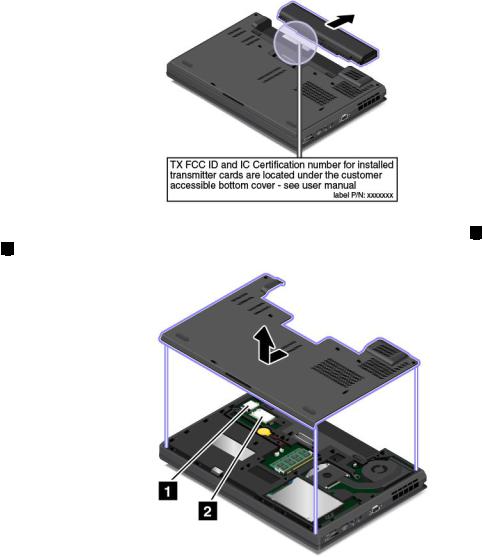
The FCC ID and IC Certification number labels are affixed on the wireless LAN card card 2 installed on your computer.
1 |
and wireless WAN |
Note: Use only Lenovo-authorized wireless communication cards for the computer. If you install an unauthorized wireless communication card that is not approved for use in your computer, an error message will be displayed and the computer will beep when you turn on the computer.
Certificate of Authenticity information
The Certificate of Authenticity label is provided on models that are licensed to use a Windows 7 operating system. The licensed Windows version and product key associated with the computer are printed on this label. Record this information and keep it in a safe place. You might need these numbers to start your computer or reinstall the Windows 7 operating system. Depending on the model, the Certificate of Authenticity label can be on the computer cover, under the battery, or on the power adapter.
For more information about the Certificate of Authenticity label, go to:
http://www.microsoft.com/en-us/howtotell/Hardware.aspx
10 User Guide
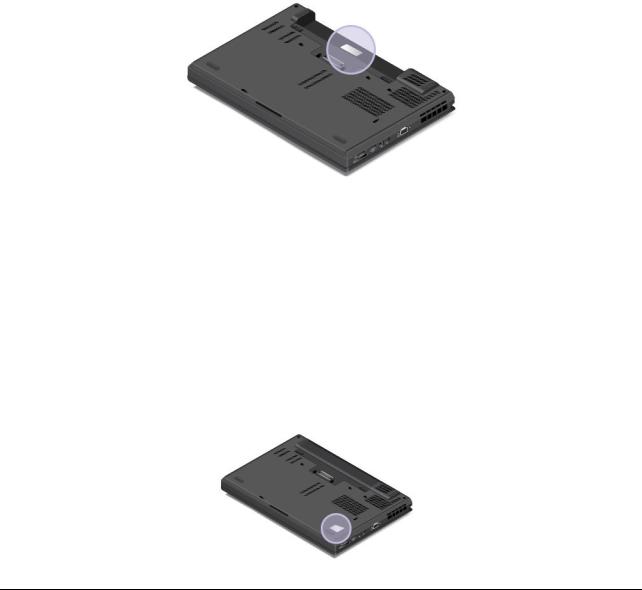
The following figure shows the location of the Certificate of Authenticity label on the computer cover:
Genuine Microsoft label
The Genuine Microsoft label is provided on models that are licensed to use a Windows 8 operating system. The version of the Windows 8 operating system is printed on the label. If your computer model is licensed to use the Windows 8 Pro operating system, that license also permits you to use the Windows 7 Professional operating system in place of the Windows 8 Pro operating system if you prefer.Lenovo computers that are licensed for use with a Windows 8 operating system are shipped with the Windows 8 license key digitally encoded into the computer hardware. Depending on the computer model, the Genuine Microsoft label can be on the computer cover, under thebattery, or on the power adapter.
For more information about the Genuine Microsoft label, go to:
http://www.microsoft.com/en-us/howtotell/Hardware.aspx
The following figure shows the location of the Genuine Microsoft label on the computer cover:
Features
This topic provides information about the computer features.
Microprocessor
•To view the microprocessor information of your computer, do the following:
–For Windows 7: Click Start, right-click Computer, and then click Properties.
–For Windows 8: From the desktop, move the cursor to the top-right or bottom-right corner of the screen to display the charms. Then click Settings PC info.
Memory
• Double data rate 3 low voltage synchronous dynamic random access memory (DDR3 LV SDRAM)
Chapter 1. Product overview 11
Storage device
Depending on the model:
•2.5-inch form factor, 9.5-mm height hard disk drive
•2.5-inch form factor, 7-mm height hard disk drive
•2.5-inch form factor, 7-mm height solid-state drive
•M.2 solid-state drive for caching only
Display
•Color display with the thin-film transistor (TFT) technology
•Display size: 355.6 mm (14 inches)
•Display resolution: 1920-by-1080, 1600–by-900, or 1280–by-720
•Brightness control
•Camera (on some models)
•Microphones
Keyboard
•6-row backlit keyboard
•Function keys
•ThinkPad pointing device
Interface
•4-in-1 media card reader
•Audio connector
•Always on USB connector
•Docking station connector
•Ethernet connector
•Mini DisplayPort connector
•Serial Ultrabay Enhanced bay
•Smart card reader (on some models)
•USB 2.0 connector
•USB 3.0 connectors
•VGA connector
GPS and wireless features
•Global Positioning System (GPS) satellite receiver (on some models)
•Bluetooth
•Wireless LAN
•Wireless WAN (on some models)
•NFC (on some models)
Security feature
• Fingerprint reader (on some models)
12 User Guide

Specifications
Size
•Width: 335 mm (13.2 inches)
•Depth: 229 mm (9 inches)
•Height: 29.95 mm (1.18 inches)
Heat output
•65 W (222 Btu/hr) maximum
•95 W (324 Btu/hr) maximum
•135 W (460 Btu/hr) maximum
Power source (ac power adapter)
•Sine-wave input at 50 to 60 Hz
•Input rating of the ac power adapter: 100 to 240 V ac, 50 to 60 Hz
Battery status
•For the percentage of the battery power remaining, check the battery status icon in the Windows notification area.
Operating environment
This section provides information about the operating environment of the computer.
Environment
•Maximum altitude without pressurization: 3048 m (10 000 ft)
•Temperature
–At altitudes up to 2438 m (8000 ft)
–Operating: 5.0°C to 35.0°C (41°F to 95°F)
–Storage: 5.0°C to 43.0°C (41°F to 109°F)
–At altitudes above 2438 m (8000 ft)
Maximum temperature when operating under the unpressurized condition: 31.3°C (88°F)
Note: When you charge the battery, its temperature must be at least 10°C (50°F).
•Relative humidity:
–Operating: 8% to 95% at wet bulb: 23 (73 )
–Storage: 5% to 95% at wet bulb: 27 (81 )
If possible, place your computer in a well-ventilated and dry area without direct exposure to sunshine.
Attention: Keep electrical appliances such as an electric fan, radio, high-powered speakers, air conditioner, and microwave oven away from your computer. The strong magnetic fields generated by electrical appliances can damage the monitor and data on the hard disk drive or solid-state drive.
Do not place any beverages on top of or beside the computer or other attached devices. If liquid is spilled on or in the computer or an attached device, a short circuit or other damage might occur.
Chapter 1. Product overview 13

Do not eat or smoke over your keyboard. Particles that fall into your keyboard can cause damage.
Lenovo programs
Your computer comes with Lenovo programs to help you work easily and securely. The available programs might vary depending on the preinstalled Windows operating system.
To learn more about the programs and other computing solutions offered by Lenovo, go to: http://www.lenovo.com/support.
Accessing Lenovo programs on the Windows 7 operating system
On the Windows 7 operating system, you can access Lenovo programs from either the Lenovo ThinkVantage® Tools program or from Control Panel.
Accessing Lenovo programs from the Lenovo ThinkVantage Tools program
To access Lenovo programs from the Lenovo ThinkVantage Tools program, click Start All Programs Lenovo ThinkVantage Tools. Then double-click a program icon to access the program.
Note: If a program icon is dimmed in the navigation window of the Lenovo ThinkVantage Tools program, it indicates that you need to manually install the program. To install the program, double-click the program icon. Then, follow the instructions on the screen. When the installation process completes, the program icon will be activated.
The following table lists the programs in the Lenovo ThinkVantage Tools program.
Note: Depending on the model, some of the programs might not be available.
Table 1. Programs in the Lenovo ThinkVantage Tools program
Program |
Icon name |
|
|
Access Connections™ |
Internet Connections |
|
|
Active Protection System™ |
Airbag Protection |
|
|
Client Security Solution |
Enhanced Security |
|
|
Communications Utility |
Web Conferencing |
|
|
Fingerprint Manager Pro |
Fingerprint Reader |
|
|
Lenovo Solution Center |
System Health and Diagnostics |
|
|
Mobile Broadband Connect |
3G Mobile Broadband |
|
|
Password Manager |
Password Vault |
|
|
Power Manager |
Power Controls |
|
|
Recovery Media |
Factory Recovery Disks |
|
|
Rescue and Recovery® |
Enhanced Backup and Restore |
System Update |
Update and Drivers |
|
|
Accessing Lenovo programs from Control Panel
To access Lenovo programs from Control Panel, click Start Control Panel. Then depending on the program you want to access, click the corresponding section and then click the corresponding green text.
Note: If you do not find the program you need in Control Panel, open the navigation window of the Lenovo ThinkVantage Tools program and double-click the dimmed icon to install the program you need. Then,
14 User Guide
